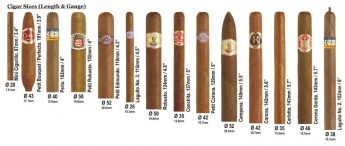Introduction
Quick Navigation
When it concerns cigars, there are a lot of factors to consider including the brand, colour, shape and size. Cigar experts know the differences in cigar shapes and sizes, so they know what type of cigar they enjoy smoking. But if you’re new to smoking cigars and you have been stuck on one type of cigar, you may be skeptical about trying out other cigars because you don’t fully understand what the factors mean or how to choose the cigar that suits your taste.
You might have a cigar that you would love to try, but it is important that you also take into consideration the cigar’s shape. Most brands do not have a definite size for all their different cigars because it’s the vitola that determines the size of the cigar and not the brand. Vitola’s have a similar length, shape and ring gauge, so it is easy to know the size of the size of the cigar by its name. for instance the Davidoff Chateau Latour, Montecristo No 3 are all Coronas. But this does not mean that every Corona will taste the same. The flavour and strength of the cigar depend on the type of tobacco used, even if you get a big cigar, but it is filled with mild tobacco, it will have a mild smoke. The only factor that the size affects is how hot the cigar will burn because thin cigars burn hotter.
Cigars are divided into two main shapes which are the parejos and figurados. Parejos are known for their straight sides, and they usually come with their feet open and ready to be lighted, but they still need to be cut before they can be smoked. Figurados are rarer than parejos, but they have been increasing in popularity. Figurados are cigars that do not have the basic cylindrical straight-sided shape.
We have compiled a guide on the shapes and sizes of cigars; hopefully, you will know a lot more about the factors that make up a cigar after going through this guide. After reading this guide, you should be able to try new cigars and choose the right smoke for you.
Cigar Shapes And Sizes
Cigar size varies from brand to brand, which is why cigars can be described by their size and shape. Two factors are used in measuring cigars: the length which is in inches and the ring gauge is the diameter of the cigar which is measured by every 64ths of an inch. A cigar that has a 38 ring gauge is measured as 38/64 inches in diameter. Keep in mind that the size of the cigar does not determine the cigar’s strength; the strength of the cigar is depends on the tobacco blend that is used in rolling the cigar. It is also important that you know that different brands of Corona will have different tastes.
Parejos
Parejos are cigars that have straight sides; they also mostly have an open foot that needs to be cut before lighting and smoking. They are either box-pressed, which means that they were pressed into a square shape before packing or got the shape due to the pressure from the box or are just round.
Types Of Parejos
Corona
This size of this cigar is used as the benchmark size for measuring other sizes of cigars, and they are quite common. The standard measurements are 5 ½ to 6 inches in length and have a ring gauge of about 42 to 44.
Petit Corona
This size is also known as a Mareva; it is basically a smaller size of the Corona. They measure at about 4 ½ inches and have a ring gauge of 40 to 42.
Churchill
These sizes of cigars are larger than a corona; they are 7 inches in length and also have a ring gauge of 47 inches. It was named after former prime minister Sir Winston Churchill who liked these kinds of cigars and had smoked approximately 300,000 types of this cigar during his lifetime. An example is the Romeo Y Julieta Churchill.
Robusta
Robusto’s have become very popular in America. They are short and fat with a 4 ¾ to 5-inch length and a ring gauge of about 48 to 54.
Corona Gorda
Which is also called Toro, has been increasing in popularity. It measures at 5 5/8 inches and has a ring gauge of 46. However, cigars that are 6 inches in length and have a 50 ring gauge have become quite popular.
Double Corona
The double Corona is similar to the shape of the Corona; it is almost double the length of a standard corona. They can reach 8 ½ inches in length and have a ring gauge of 49 to 52, which is quite big.
Lonsdale
A Lonsdale is longer than a corona with it reaching 6 ½ inches in length and also has a ring gauge of 42. An example is the Montecristo No. 1.
Panatela
This panatela is long and thin, but its popularity has reduced over the years. It has a length variation of 5 to 7 ½ inches with a ring gauge of 34 to 38. Cigars that are longer than 7 inches s usually called “Gran Panatelas” such as a Cohiba Lancero.
Figurados
Even though most of the cigars made these days are Parejos, some brands like to try out a new thing and get quite creative. Any cigar that does not have straight sides is called a Figurado.
Pyramid
This size of this cigar is one of the most popular figurado sizes. It has a tapered point at the top of the cigar but has a cut foot. These sizes of cigars are usually 6 to 7 inches in length with a ring gauge of 40 at the tapered end and 52 to 54 gauge at the foot.
Belicoso
Belicosos are usually short pyramids that often have a round pyramid head. They are usually 5 to 5 ½ inches in length and have a ring gauge of 50.
Torpedo
This cigar is rare to find; it usually has a closed foot with a head that is tapered to form a point and has a bulge in the middle.
Perfecto
The perfecto also has a closed foot with a bulge in its middle. But the head of the cigar is round like that of a Parejo. They vary in length and can reach up to 9 inches with a 38 to 48 ring gauge.
Conclusion
With this guide, you should be able to decide what cigar you would like to try next without feeling confused.

